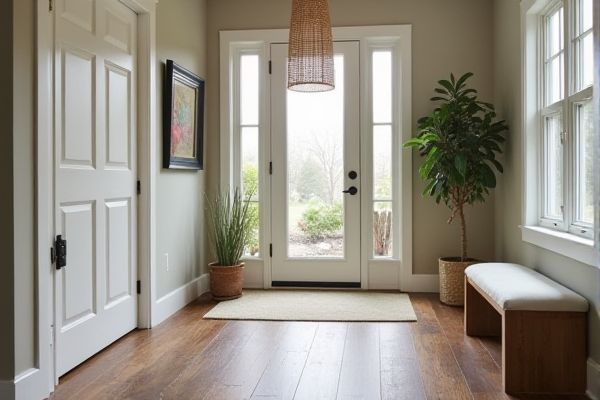
A drop zone is a small, organized area near an entryway designed for quickly storing everyday items like keys, bags, and shoes, while a mudroom functions as a larger, more robust space dedicated to keeping dirt and mud from entering the home by offering ample storage for coats, boots, and outdoor gear. Discover how understanding the differences between a drop zone and a mudroom can help you create a more efficient entryway tailored to your lifestyle.
Table of Comparison
| Feature | Drop Zone | Mudroom |
|---|---|---|
| Primary Purpose | Temporary storage for daily items like keys, bags, and mail | Entryway space for removing and storing shoes, coats, and wet gear |
| Location | Near main entrances, often kitchen or garage entry | Adjacent to back or side entry, often near laundry area |
| Typical Features | Hooks, small shelving, cubbies, charging stations | Bench seating, coat hooks, shoe racks, durable flooring |
| Functionality | Organizes high-traffic daily essentials for quick grab-and-go | Manages dirt and wet items, keeping home clean and organized |
| Design Focus | Compact, convenience, and efficient storage | Robust, practical, often with mud-resistant materials |
| Space Requirements | Small footprint, integrated within existing room | Larger area, dedicated or semi-dedicated room |
| Common Materials | Wood, metal hooks, plastic bins | Waterproof flooring, bench wood, durable fabrics |
Understanding Drop Zones and Mudrooms
Drop zones serve as designated areas near entryways for organizing everyday items like keys, bags, and mail, enhancing home functionality and reducing clutter. Mudrooms often function as transitional spaces equipped with seating, storage for footwear and outerwear, and washable surfaces, designed to manage dirt and debris from outdoors. While both improve home organization, drop zones focus on quick item drop-off and retrieval, whereas mudrooms emphasize cleanliness and storage for outdoor gear.
Key Functions of Drop Zones
Drop zones serve as organized entryway hubs designed to manage daily essentials like keys, backpacks, and mail, preventing clutter from spreading throughout the home. These spaces often include hooks, shelves, and cubbies to streamline storage and promote quick accessibility. Unlike mudrooms, drop zones prioritize convenience and efficiency for everyday item management rather than handling muddy footwear or outerwear.
Essential Features of a Mudroom
Mudrooms are designed with essential features such as built-in storage benches, hooks for coats, and cubbies for shoes, creating an organized transition space from outdoors to indoors. You can expect durable, easy-to-clean flooring and ample lighting to maintain functionality and cleanliness. These elements make mudrooms ideal for managing clutter and protecting your home's interior from dirt and moisture.
Design Differences: Drop Zone vs Mudroom
A drop zone typically occupies a small, strategic area near entryways designed for quick organization of keys, bags, and mail, emphasizing compact efficiency with shelves, hooks, and cubbies. In contrast, a mudroom functions as a dedicated space blending utility and storage for outerwear, footwear, and cleaning needs, often featuring benches, built-in lockers, and durable flooring to handle dirt and moisture. While drop zones prioritize minimalism and accessibility, mudrooms focus on comprehensive storage and functionality tailored to manage messier outdoor gear.
Space Requirements and Layout Ideas
Drop zones typically require minimal space, often designed as compact, functional nooks near entryways for storing shoes, bags, and keys. Mudrooms demand larger areas to accommodate benches, storage cubbies, and cleaning stations, ideal for managing wet or muddy gear. Your choice depends on available square footage and whether you prefer a simple organizational spot or a multi-use space for household clutter.
Storage Solutions: Drop Zone vs Mudroom
Drop zones offer compact storage solutions tailored for busy entryways, featuring hooks, cubbies, and small shelves that organize everyday essentials like keys, bags, and shoes. Mudrooms provide more extensive storage options, including built-in benches, lockers, and large cabinets designed to handle heavy-duty gear and seasonal items, making them ideal for larger households. Both spaces enhance home organization, but mudrooms prioritize durability and capacity while drop zones focus on convenience and space-saving functionality.
Organization Tips for Each Space
Maximize drop zone efficiency by incorporating wall-mounted hooks, cubbies, and labeled bins to store coats, backpacks, and shoes, preventing clutter from entering the home. In the mudroom, use waterproof storage benches and durable shelving to manage wet gear and outdoor equipment while keeping flooring protected and easy to clean. Both spaces benefit from designated zones for frequently used items, enhancing daily routines and maintaining overall home organization.
Style and Aesthetic Considerations
Drop zones often feature sleek, minimalist designs with built-in storage solutions that blend seamlessly into modern interiors, while mudrooms embrace a more rustic or farmhouse style with durable materials such as wood and tile to handle heavy traffic and dirt. Your choice depends on your home's overall aesthetic: drop zones provide a clean, organized look ideal for contemporary spaces, whereas mudrooms offer a cozy, functional space that complements traditional or country-inspired decor. Both styles can be customized with hooks, shelves, and seating to enhance usability without sacrificing visual appeal.
Choosing the Right Option for Your Home
Selecting between a drop zone and a mudroom depends on your home's layout and lifestyle needs. A drop zone offers a compact, organized space for keys, bags, and mail, perfect for smaller homes or apartments with limited entryway space. Your choice should prioritize convenience and functionality, ensuring it effectively manages daily clutter while complementing your home's design.
Cost and Installation Comparison
Drop zones typically have a lower cost and simpler installation, often requiring only basic shelving or wall hooks, making them budget-friendly for quick organization solutions. Mudrooms involve more extensive construction, including flooring, built-in storage, and sometimes plumbing or lighting upgrades, resulting in higher installation costs and longer project timelines. Your choice depends on your budget and willingness to invest in a functional, dedicated space versus a minimalist entryway organizer.
 homyna.com
homyna.com